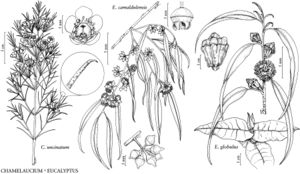Difference between revisions of "Eucalyptus globulus"
Voy. Rech. Pérouse 1: 153, plate 13. 1800.
imported>Volume Importer |
imported>Volume Importer |
||
| Line 50: | Line 50: | ||
|publication year=1800 | |publication year=1800 | ||
|special status= | |special status= | ||
| − | |source xml=https://xjsachs2@bitbucket.org/aafc-mbb/fna-data-curation.git/src/ | + | |source xml=https://xjsachs2@bitbucket.org/aafc-mbb/fna-data-curation.git/src/e39f0e846f172941159b2045254d62d10d9823f6/coarse_grained_fna_xml/V10/V10_714.xml |
|genus=Eucalyptus | |genus=Eucalyptus | ||
|species=Eucalyptus globulus | |species=Eucalyptus globulus | ||
Latest revision as of 10:33, 9 May 2022
Trees, to 60 m; trunk bluish gray, straight, smooth; bark shed in irregular strips distally, sometimes persistent toward trunk base; twigs ± square or winged. Leaves mostly strongly aromatic; petiole 1.5–2.5 cm, flattened; blade green, usually narrowly lanceolate, often sickle-shaped, 10–30 × 2.5–4 cm. Peduncles 0.1–1 cm. Inflorescences: flowers solitary, sessile or subsessile. Flowers: hypanthium obconic, ± 4-ribbed, to 20 mm, glaucous; calyptra flattened-hemispheric, with central knob, warty, glaucous; stamens creamy white. Capsules hemispheric or obconic, ± 4-ribbed, 5–21 mm, glaucous, thickened, warty, rim wide; valves 3–5, ± level with apex or exserted. 2n = 22.
Phenology: Flowering fall–winter.
Habitat: Disturbed areas.
Elevation: 0–300 m.
Distribution
Introduced; Calif., se Australia
Discussion
Eucalyptus globulus is known from the Outer North Coast Ranges, Great Central Valley, and central-western and southwestern California.
Eucalyptus globulus is commonly cultivated in warm regions of the world for its fast-growing timber and for paper pulp. The species is the tallest angiosperm in North America, easily recognized by the large, solitary flowers and fruit.
Selected References
None.
